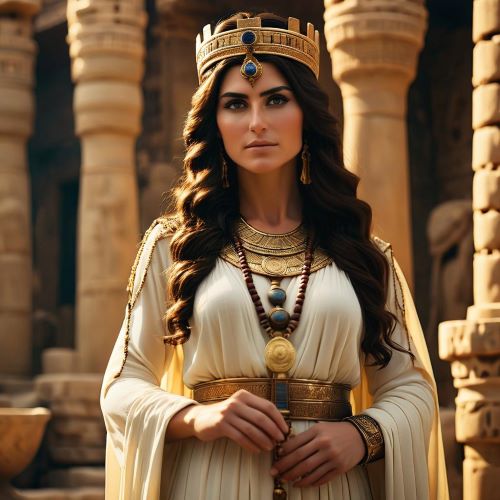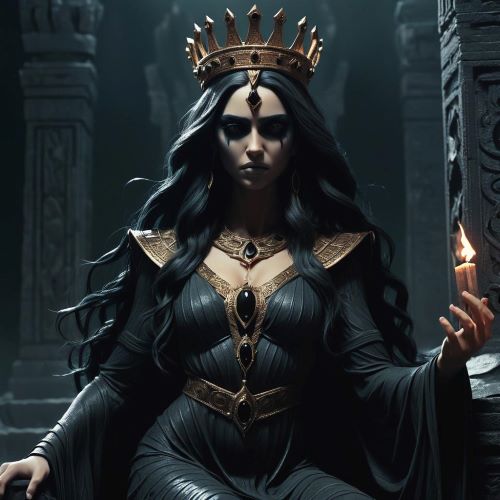Lahamu : The Primordial Goddess
Listen
At a glance
| Description | |
|---|---|
| Origin | Asian Mythology |
| Classification | Gods |
| Family Members | Tiamat (Father), Apsu (Mother), Lahmu (Brother), Anshar, Kishar (Children) |
| Region | Iraq, Syria |
| Associated With | Creation |
Lahamu
Introduction
Lahamu is one of the earliest divine figures in Akkadian and Babylonian mythology, remembered as a primordial goddess who embodies the transition from chaos to order. She appears in the Enuma Elish, the Babylonian creation epic, where she is born from the mingling of the primeval waters of Apsu and Tiamat. Alongside her twin brother and consort Lahmu, she represents the earliest phase of divine generation and stands at the threshold of the cosmos’s unfolding. Although her appearances in texts are brief, Lahamu’s symbolic role as one of the firstborn deities makes her essential to the mythological structure that led to the rise of the great Mesopotamian gods.
Physical Traits
Unlike later Mesopotamian gods, who were often depicted with human features, Lahamu’s appearance is more symbolic, reflecting her primordial origins. Her name is sometimes translated as “slime” or “mud,” linking her directly to the raw, undifferentiated matter from which life emerges. Ancient interpretations often envisioned her as having aquatic or serpentine qualities, echoing her connection to the chaotic waters of creation. While there are no consistent images of Lahamu preserved in art, scholars suggest she may have been imagined with flowing forms, scaled or fluid-like bodies, and possibly serpentine heads, much like other beings tied to watery chaos. These traits symbolized her position as a bridge between the formless abyss and the structured universe that followed.
Family
Lahamu belongs to the earliest divine family of Mesopotamian mythology. She is the daughter of Tiamat, the goddess of saltwater chaos, and Apsu, the embodiment of freshwater. Together with her twin brother Lahmu, she gives birth to Anshar and Kishar, who symbolize the sky and earth. These deities in turn are ancestors of Anu, the sky god, who became a central figure in Mesopotamian religion. Through this lineage, Lahamu connects the chaotic beginnings of the cosmos to the structured pantheon of gods that would dominate later myths. Her role as mother and ancestor makes her vital to the divine genealogy, ensuring continuity from the primordial void to the organized world.
Other names
Lahamu’s identity in Mesopotamian cosmology is relatively stable, with her name appearing consistently in Akkadian texts as 𒀭𒆷𒄩𒈬 (d la-ḫa-mu). However, her association with her twin brother and husband Lahmu has sometimes caused confusion in interpretation. Lahmu’s name, meaning “hairy” or “shaggy,” often led to depictions of him as a protective figure, which later traditions linked to guardian spirits such as the Shedu or Lamassu. Some early scholars speculated that Lahamu herself may have been a feminine counterpart to these apotropaic beings, though modern interpretations place her firmly in the realm of primordial deities rather than protective spirits. Unlike Tiamat, whose identity expanded across myths, Lahamu retained a specific place in the genealogy of creation, making her a distinct figure rather than a fluid symbol of chaos.
Powers and Abilities
Lahamu’s powers are not described in terms of combat or rule, as seen with later deities like Marduk or Ishtar, but in her generative and symbolic role. She represents the potential of chaos to create structure. Her union with Lahmu brings forth Anshar and Kishar, the turning point in the divine narrative where the cosmos gains order. As such, Lahamu embodies the power of transition, existing between the primordial void and the pantheon of organized gods. In Mesopotamian thought, this role was profound, as it framed her not as a warrior goddess but as a necessary force of continuity and balance. Her ability to give life to the next divine generation reflects the ancient understanding that creation itself emerges from chaos.
Modern Day Influence
Though Lahamu is not widely recognized in popular culture compared to deities like Tiamat or Marduk, her legacy continues in several areas. Academically, she remains a central subject in the study of Mesopotamian cosmogony. The Enuma Elish, preserved on Babylonian tablets, is frequently analyzed by historians and linguists to understand ancient views on creation, with Lahamu consistently appearing as a key figure in the second generation of gods. Comparative mythology also places her alongside figures such as Gaia in Greek tradition and Nammu in Sumerian belief, highlighting the recurring motif of primordial mothers in world mythologies.
In modern literature and art, Lahamu’s symbolic role as a goddess of transition has inspired reinterpretations, especially in works that explore the boundary between chaos and order. Writers and visual artists sometimes draw upon her as a metaphor for beginnings, transformation, or the hidden forces that underlie creation. Digital platforms, including educational projects and mythology-focused websites, also contribute to reviving interest in figures like Lahamu, presenting her as part of the intricate narrative of Mesopotamian religion.
Today, her influence survives less in religious devotion and more in cultural, academic, and artistic spheres, where she embodies humanity’s enduring fascination with the origins of existence. Her story reminds us that even the least-described deities played a crucial role in shaping the grand mythological vision of how the universe began.
Related Images
Source
Contributors to Wikimedia projects. (n.d.). Lahamu – Wikipedia. https://en.wikipedia.org/wiki/Lahamu
Britannica. (n.d.). Lahmu and Lahamu God, Apsu, Tiamat, & Mythology. Encyclopedia Britannica. Retrieved September 13, 2025, from https://www.britannica.com/topic/Lahmu-and-Lahamu
Mythology Worldwide. (2024, May 22). The Myth of Lahmu and Lahamu: Primordial Deities in Mesopotamian Mythology. Retrieved September 13, 2025, from https://mythologyworldwide.com/the-myth-of-lahmu-and-lahamu-primordial-deities-in-mesopotamian-mythology/
Wiggermann, F. A. M. (1992). Mesopotamian protective spirits: The ritual texts. Brill.
King, L. W. (1902). The seven tablets of creation: Or the Babylonian and Assyrian legends concerning the creation of the world and of mankind. Luzac & Co.
[Available via Archive.org]: https://archive.org/details/cu31924026893150
Frequently Asked Questions
What is lorem Ipsum?
I am text block. Click edit button to change this text. Lorem ipsum dolor sit amet, consectetur adipiscing elit. Ut elit tellus, luctus nec ullamcorper mattis, pulvinar dapibus leo.
What is lorem Ipsum?
I am text block. Click edit button to change this text. Lorem ipsum dolor sit amet, consectetur adipiscing elit. Ut elit tellus, luctus nec ullamcorper mattis, pulvinar dapibus leo.
What is lorem Ipsum?
I am text block. Click edit button to change this text. Lorem ipsum dolor sit amet, consectetur adipiscing elit. Ut elit tellus, luctus nec ullamcorper mattis, pulvinar dapibus leo.
What is lorem Ipsum?
I am text block. Click edit button to change this text. Lorem ipsum dolor sit amet, consectetur adipiscing elit. Ut elit tellus, luctus nec ullamcorper mattis, pulvinar dapibus leo.
What is lorem Ipsum?
I am text block. Click edit button to change this text. Lorem ipsum dolor sit amet, consectetur adipiscing elit. Ut elit tellus, luctus nec ullamcorper mattis, pulvinar dapibus leo.










